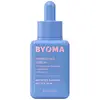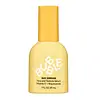What's inside
What's inside
 Key Ingredients
Key Ingredients

 Benefits
Benefits

 Concerns
Concerns

 Ingredients Side-by-side
Ingredients Side-by-side

Water
Skin ConditioningGlycerin
HumectantButylene Glycol
HumectantSqualane
EmollientSodium Stearoyl Glutamate
CleansingAmmonium Acryloyldimethyltaurate/Vp Copolymer
Dipropylene Glycol
HumectantCeramide NP
Skin ConditioningCaprylic/Capric Triglyceride
MaskingCholesterol
EmollientPhytosphingosine
Skin ConditioningStearic Acid
CleansingOleic Acid
EmollientHydroxyacetophenone
AntioxidantPolyglyceryl-4 Oleate
EmulsifyingHydroxyethyl Acrylate/Sodium Acryloyldimethyl Taurate Copolymer
Emulsion StabilisingHydrogenated Lecithin
EmulsifyingCaprylyl Glycol
EmollientGlyceryl Oleate
EmollientLactic Acid
BufferingEthylhexylglycerin
Skin ConditioningHydrogenated Rapeseed Alcohol
EmollientSorbitan Isostearate
EmulsifyingSodium Phytate
Xanthan Gum
EmulsifyingDipotassium Glycyrrhizate
HumectantTocopherol
AntioxidantCaprylhydroxamic Acid
Water, Glycerin, Butylene Glycol, Squalane, Sodium Stearoyl Glutamate, Ammonium Acryloyldimethyltaurate/Vp Copolymer, Dipropylene Glycol, Ceramide NP, Caprylic/Capric Triglyceride, Cholesterol, Phytosphingosine, Stearic Acid, Oleic Acid, Hydroxyacetophenone, Polyglyceryl-4 Oleate, Hydroxyethyl Acrylate/Sodium Acryloyldimethyl Taurate Copolymer, Hydrogenated Lecithin, Caprylyl Glycol, Glyceryl Oleate, Lactic Acid, Ethylhexylglycerin, Hydrogenated Rapeseed Alcohol, Sorbitan Isostearate, Sodium Phytate, Xanthan Gum, Dipotassium Glycyrrhizate, Tocopherol, Caprylhydroxamic Acid
Water
Skin ConditioningSodium Ascorbyl Phosphate
AntioxidantCoco-Caprylate/Caprate
EmollientGlycerin
HumectantNiacinamide
SmoothingAlpha-Arbutin
AntioxidantTranexamic Acid
AstringentCeramide NP
Skin ConditioningCeramide AP
Skin ConditioningCeramide As
Skin ConditioningCholesterol
EmollientCeramide Ns
Skin ConditioningCeramide EOP
Skin ConditioningXanthan Gum
EmulsifyingBrassica Campestris Seed Oil
Skin ConditioningEthylhexylglycerin
Skin ConditioningGlycyrrhiza Glabra Root Extract
BleachingPolyglyceryl-3 Diisostearate
EmulsifyingSorbitan Isostearate
EmulsifyingHydrogenated Lecithin
EmulsifyingAlthaea Officinalis Root Extract
Skin ConditioningOryza Sativa Bran Extract
Skin ConditioningDipropylene Glycol
HumectantGlyceryl Stearate
EmollientHydroxyethyl Acrylate/Sodium Acryloyldimethyl Taurate Copolymer
Emulsion StabilisingSodium Polyacryloyldimethyl Taurate
Emulsion StabilisingSodium Polyacrylate
AbsorbentSucrose Distearate
EmollientPhenoxyethanol
PreservativeWater, Sodium Ascorbyl Phosphate, Coco-Caprylate/Caprate, Glycerin, Niacinamide, Alpha-Arbutin, Tranexamic Acid, Ceramide NP, Ceramide AP, Ceramide As, Cholesterol, Ceramide Ns, Ceramide EOP, Xanthan Gum, Brassica Campestris Seed Oil, Ethylhexylglycerin, Glycyrrhiza Glabra Root Extract, Polyglyceryl-3 Diisostearate, Sorbitan Isostearate, Hydrogenated Lecithin, Althaea Officinalis Root Extract, Oryza Sativa Bran Extract, Dipropylene Glycol, Glyceryl Stearate, Hydroxyethyl Acrylate/Sodium Acryloyldimethyl Taurate Copolymer, Sodium Polyacryloyldimethyl Taurate, Sodium Polyacrylate, Sucrose Distearate, Phenoxyethanol
 Reviews
Reviews

Ingredients Explained
These ingredients are found in both products.
Ingredients higher up in an ingredient list are typically present in a larger amount.
Ceramide NP is a type of ceramide.
Ceramides are intercellular lipids naturally found in our skin that bonds dead skin cells together to create a barrier. They are known for their ability to hold water and thus are a great ingredient for dry skin.
Ceramides are an important building block for our skin barrier. A stronger barrier helps the skin look more firm and hydrated. By bolstering the skin ceramides act as a barrier against irritating ingredients. This can help with inflammation as well.
If you would like to eat ceramides, sweet potatoes contain a small amount.
Read more about other common types of ceramides here:
Ceramide AP
Ceramide EOP
Cholesterol is a class of organic molecules called lipids. It helps hydrate your skin and is essential to having a healthy skin barrier.
Our skin naturally contains cholesterol in the outermost layer. Besides cholesterol, it also contains ceramides and fatty acids. Cholesterol makes up about 1/4 of your skin's outer layer and barrier. Your skin barrier is responsible for keeping allergens and microbes out. Having a healthy skin barrier is also responsible for keeping your skin firm and plump.
Our bodies use cholestrol to create vitamin D, steroid hormones, and more.
Learn more about CholesterolDipropylene Glycol is a synthetically created humectant, stabilizer, and solvent.
This ingredient helps:
Dipropylene glycol is technically an alcohol, but it belongs to the glycol family (often considered part of the ‘good’ alcohols). This means it is hydrating and gentle on skin unlike drying solvent alcohols like denatured alcohol.
As a masking agent, Dipropylene Glycol can be used to cover the smell of other ingredients. However, it does not have a scent.
Studies show Dipropylene Glycol is considered safe to use in skincare.
Learn more about Dipropylene GlycolEthylhexylglycerin (we can't pronounce this either) is commonly used as a preservative and skin softener. It is derived from glyceryl.
You might see Ethylhexylglycerin often paired with other preservatives such as phenoxyethanol. Ethylhexylglycerin has been found to increase the effectiveness of these other preservatives.
Glycerin is already naturally found in your skin. It helps moisturize and protect your skin.
A study from 2016 found glycerin to be more effective as a humectant than AHAs and hyaluronic acid.
As a humectant, it helps the skin stay hydrated by pulling moisture to your skin. The low molecular weight of glycerin allows it to pull moisture into the deeper layers of your skin.
Hydrated skin improves your skin barrier; Your skin barrier helps protect against irritants and bacteria.
Glycerin has also been found to have antimicrobial and antiviral properties. Due to these properties, glycerin is often used in wound and burn treatments.
In cosmetics, glycerin is usually derived from plants such as soybean or palm. However, it can also be sourced from animals, such as tallow or animal fat.
This ingredient is organic, colorless, odorless, and non-toxic.
Glycerin is the name for this ingredient in American English. British English uses Glycerol/Glycerine.
Learn more about GlycerinHydrogenated Lecithin is created from the hydrogenation of lecithin (a group of phospholipids). Hydrogenation is a chemical reaction between hydrogen and another element.
This ingredient is an emollient and emulsifier. As an emollient, it helps soften skin by trapping moisture within. As an emulsifier, it prevents oil and water ingredients from separating.
This is a synthetic polymer. It helps improve the texture of products by adding thickness and gel-like feel.
It is also an emulsifer, meaning it prevents ingredients such as oil and water from separating. It also helps evenly disperse other ingredients.
Sorbitan Isostearate is an emulsifer and cleaning agent. It is created from isostearic acid and sorbitol.
As an emulsifier, Sorbitan Isostearate prevents oils and water from separating.
Due to its isostearic acid base, it may not be safe for Malassezia or fungal acne.
Learn more about Sorbitan IsostearateWater. It's the most common cosmetic ingredient of all. You'll usually see it at the top of ingredient lists, meaning that it makes up the largest part of the product.
So why is it so popular? Water most often acts as a solvent - this means that it helps dissolve other ingredients into the formulation.
You'll also recognize water as that liquid we all need to stay alive. If you see this, drink a glass of water. Stay hydrated!
Learn more about WaterXanthan gum is used as a stabilizer and thickener within cosmetic products. It helps give products a sticky, thick feeling - preventing them from being too runny.
On the technical side of things, xanthan gum is a polysaccharide - a combination consisting of multiple sugar molecules bonded together.
Xanthan gum is a pretty common and great ingredient. It is a natural, non-toxic, non-irritating ingredient that is also commonly used in food products.
Learn more about Xanthan Gum